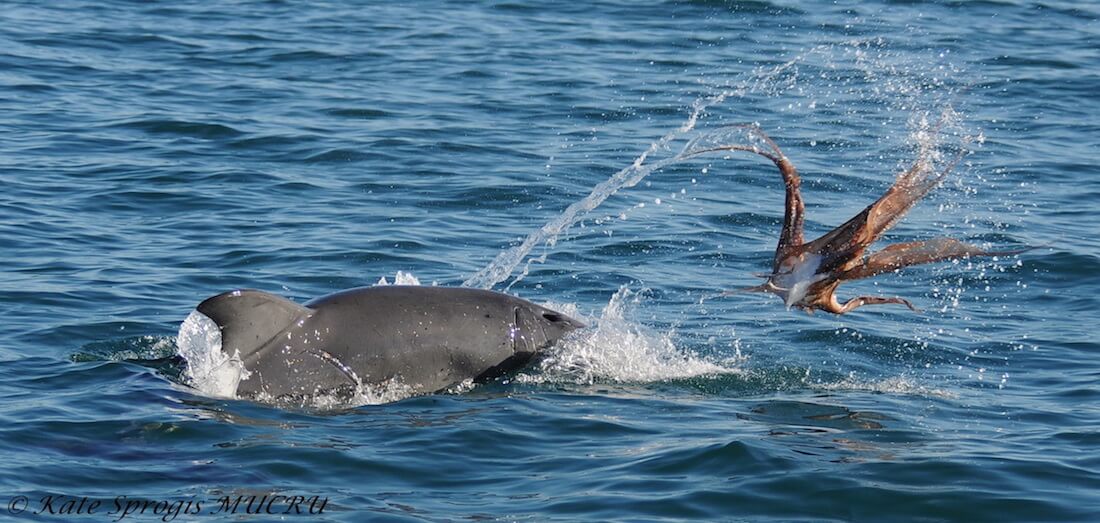With no hands, how can one get the better of a live eight-armed prey measuring over one metre long equipped with suction cups and capable of suffocating its attacker? Is this the job of a great chef or a predator’s worst nightmare? In a recent study, behavioural ecologist Kate Sprogis (University of Murdoch, Australia) and her colleagues describe in detail for the first time a few of the techniques used by the Indo-Pacific bottlenose dolphin to safely prey upon the octopus, an immense and dangerous animal.
Predators wishing to feed on large live prey that cannot be eaten whole must develop techniques to control and transform their prey before ingesting them. Various techniques have been developed, notably by crocodiles, alligators, sea leopards and toothed whales to break their prey into pieces and tenderize their flesh. For example, killer whales shake the seals and belugas that they catch and toss dolphins and stingrays into the air. Bottlenose dolphins, on the other hand, shake and throw fish about to break it into small chunks and soften it before consumption. These dolphins have also developed a complex technique to break the giant cuttlefish into pieces using a sequence of steps to remove the head, ink and cuttlebone.
In the study conducted by Kate Sprogis and her colleagues, researchers observed 45 episodes of Indo-Pacific bottlenose dolphins (Tursiops aduncus) handling octopus. Two different techniques were observed. In the first technique, the dolphin arches and raises its body out of the water while it holds the octopus in its jaws and slaps it forcefully on the water surface. In the second technique, instead of keeping its jaws closed when it arches and lifts its body and the octopus out of the water, the dolphin opens its mouth, throwing the octopus into the air, often over several metres. The dolphin then recovers the octopus and continues to shake it and slap it on the water surface (usually 10 to 15 times). Researchers suggest that the dolphin behaves this way to remove the octopus’ head and mantle, soften its flesh, ensure that its arms are inactive and separate the animal into sections to facilitate ingestion.
For dolphins, eating an octopus is apparently a complex, energy-intensive and highly risky task. The handling techniques observed by researchers involve tremendous body movement: the dolphin must arch and lift its body out of the water to shake or throw the octopus into the air. Although this technique is undoubtedly quite energy intensive, it allows dolphins to consume large prey, possibly of great nutritional value, which would be risky to ingest without some sort of pre-treatment. Dolphins have been found asphyxiated by octopus arms which they apparently did not properly neutralize before ingestion.
Octopus arms have receptors that allow them to detect what is causing damage to their tissues and to continue to react even if they are no longer attached to the head. The dolphins must therefore handle the octopus in such a way as to eliminate or sufficiently reduce the defensive reflex of the arms and the action of the suction cups, otherwise ingestion may result in the predator’s suffocating.
The predation episodes observed by Kate Sprogis and her colleagues occurred mainly during winter and spring, which could correspond to the octopus’s senescence stage. Octopuses are semelparous, that is to say that they reproduce only once during their lifetime, and then die shortly after. After mating and looking after their eggs, they undergo a period of senescence, which lasts about a month, during which they exhibit disorderly movements, suboptimal camouflage, and deteriorating physical condition. They are thus more vulnerable to predation.
Most of the dolphins observed handling octopus were adults. Does this reflect differing nutritional needs between adults and young, or perhaps a required learning period before taking up octopus hunting? Feeding techniques for toothed whales, which often target large, mobile and sometimes even dangerous prey, generally require a long learning period. Because capturing and controlling a prey with eight arms and hundreds of suckers is an operation worthy of a great chef!





